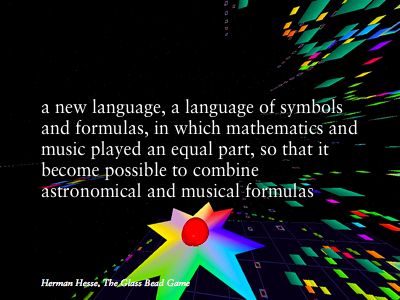
Let’s finish on metaphors.
I’ve been told that the way I think is to come up with counterfactual universes, find the obvious products in them, and bring them back. I’ll go with that. These are some of my favourite big metaphors.
I’m big on games, and how they reflect how we think. The following few slides are from Herman Hesse’s The Glass Bead Game, and describe the game of the title.
The background images are from a video game named Tranquility, where you float around, bouncing from the tiles you see, to collect the star in the foreground. There’s one of those per level, and since everything – including the tiles – is moving in swirls and spirals, these images barely communicate the experience of it. When I was looking for something that would illustrate the structure, interaction and precariousness of the intellectual idea navigation that is the Glass Bead Game, Tranquility came to mind. (The images are from the Screenshots page on the Tranquility website.)
Anyway, this is the game:
It’s “a new language, a language of symbols and formulas, in which mathematics and music played an equal part, so that it become possible to combine astronomical and musical formulas”